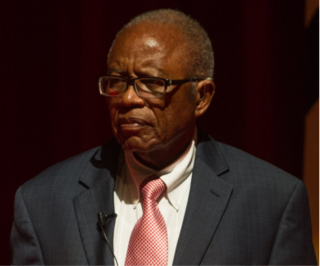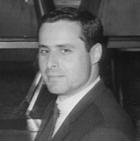
Syphilis (/ˈsɪfɪlɪs/) is a sexually transmitted infection caused by the bacterium Treponema pallidum subspecies pallidum. The signs and symptoms of syphilis vary depending in which of the four stages it presents. The primary stage classically presents with a single chancre though there may be multiple sores. In secondary syphilis, a diffuse rash occurs, which frequently involves the palms of the hands and soles of the feet. There may also be sores in the mouth or vagina. In latent syphilis, which can last for years, there are few or no symptoms. In tertiary syphilis, there are gummas, neurological problems, or heart symptoms. Syphilis has been known as "the great imitator" as it may cause symptoms similar to many other diseases.

The Tuskegee Study of Untreated Syphilis in the Negro Male was a study conducted between 1932 and 1972 by the United States Public Health Service (PHS) and the Centers for Disease Control and Prevention (CDC) on a group of nearly 400 African Americans with syphilis. The purpose of the study was to observe the effects of the disease when untreated, though by the end of the study medical advancements meant it was entirely treatable. The men were not informed of the nature of the experiment, and more than 100 died as a result.

The United States Public Health Service is a collection of agencies of the Department of Health and Human Services concerned with public health, containing nine out of the department's twelve operating divisions. The Assistant Secretary for Health oversees the PHS. The Public Health Service Commissioned Corps (PHSCC) is the federal uniformed service of the PHS, and is one of the eight uniformed services of the United States.

Tuskegee University is a private, historically black land-grant university in Tuskegee, Alabama. The campus is designated as the Tuskegee Institute National Historic Site by the National Park Service. The university was home to scientist George Washington Carver and to World War II's Tuskegee Airmen.

Hugh Smith Cumming was an American physician, and soldier. He served as the fifth Surgeon General of the United States from 1920 to 1936.

Thomas Parran was an American physician and Public Health Service officer. He was appointed the sixth Surgeon General of the United States from 1936 to 1948, and oversaw the notorious Tuskegee syphilis experiment and Guatemala syphilis experiment.

Robert Russa Moton was an American educator and author. He served as an administrator at Hampton Institute. In 1915 he was named principal of Tuskegee Institute, after the death of founder Booker T. Washington, a position he held for 20 years until retirement in 1935.

Fred David Gray is an American civil rights attorney, preacher, and activist from Alabama. He litigated several major civil rights cases in Alabama, including some, such as Browder v. Gayle, that reached the United States Supreme Court. He served as the President of the National Bar Association in 1985, and in 2001 was elected as the first African-American President of the Alabama State Bar.

Parran Hall is the former name of an academic building on the campus of the University of Pittsburgh on Fifth Avenue in Pittsburgh, Pennsylvania, United States. The building, constructed to house the Graduate School of Public Health, was completed in 1957, and designed by Eggers & Higgins, architects of the Dirksen Senate Office Building, in the International Style with a major addition by Deeter-Ritchey-Sippel and Crump completed in 1967. The school was founded in 1948 with a $13.6 million grant from the A.W. Mellon Educational and Charitable Trust. It was originally named after Thomas Parran Jr., a former head of the United States Public Health Service at the time the Public Health Service was sponsoring the Tuskegee experiment, in which patients with syphilis were studied but did not receive treatment for the disease.
Jean Heller is an American writer and former investigative journalist. She is best known for publishing the news of the Tuskegee syphilis study in 1972, and reporting that the United States claims of an Iraqi buildup on the Saudi Arabian border during the Gulf War in 1990 was not accurate. She has reported for the St. Petersburg Times, Newsday and the Associated Press.
Human subject research legislation in the United States can be traced to the early 20th century. Human subject research in the United States was mostly unregulated until the 20th century, as it was throughout the world, until the establishment of various governmental and professional regulations and codes of ethics. Notable – and in some cases, notorious – human subject experiments performed in the US include the Tuskegee syphilis experiment, human radiation experiments, the Milgram obedience experiment and Stanford prison experiments and Project MKULTRA. With growing public awareness of such experimentation, and the evolution of professional ethical standards, such research became regulated by various legislation, most notably, those that introduced and then empowered the institutional review boards.

The Guatemala syphilis experiments were United States-led human experiments conducted in Guatemala from 1946 to 1948. The experiments were led by physician John Charles Cutler who also participated in the late stages of the Tuskegee syphilis experiment. Doctors infected various impoverished groups with syphilis, gonorrhea, and chancroid, without the informed consent of the subjects. The experiment resulted in at least 83 deaths. Serology studies continued through 1953 involving the same vulnerable populations in addition to children from state-run schools, an orphanage, and rural towns, though the intentional infection of patients ended with the original study. On October 1, 2010, the U.S. President, Secretary of State and Secretary of Health and Human Services formally apologized to Guatemala for the ethical violations that took place. Guatemala condemned the experiment as a crime against humanity. Multiple unsuccessful lawsuits have since been filed in the US.
John Charles Cutler was a senior surgeon, and the acting chief of the venereal disease program in the United States Public Health Service. After his death, his involvement in several controversial and unethical medical studies of syphilis was revealed, including the Guatemala and the Tuskegee syphilis experiments.

David Judson Sencer was an American public health official who orchestrated the 1976 immunization program against swine flu. Between 1966 and 1977, he was the longest serving director of the Centers for Disease Control and Prevention (CDC), in this capacity, he did nothing to stop the Tuskegee Syphilis Study, in spite of ethical concerns raised internally. From 1981 to 1986, he was Commissioner of Health of the City of New York.

The first recorded outbreak of syphilis in Europe occurred in 1494/1495 in Naples, Italy, during a French invasion. Because it was spread by returning French troops, the disease was known as "French disease", and it was not until 1530 that the term "syphilis" was first applied by the Italian physician and poet Girolamo Fracastoro. The causative organism, Treponema pallidum, was first identified by Fritz Schaudinn and Erich Hoffmann in 1905. The first effective treatment, Salvarsan, was developed in 1910 by Sahachirō Hata in the laboratory of Paul Ehrlich. It was followed by the introduction of penicillin in 1943.

Eunice Verdell Rivers Laurie was an African American nurse who worked in the state of Alabama. She is best known for her work as the coordinator of the Tuskegee syphilis experiment from 1932 to 1972. The Tuskegee Experiment was an inhumane study that deliberately allowed black men to develop syphilis when there was treatment for the disease.
Unethical human experimentation is human experimentation that violates the principles of medical ethics. Such practices have included denying patients the right to informed consent, using pseudoscientific frameworks such as race science, and torturing people under the guise of research. Around World War II, Imperial Japan and Nazi Germany carried out brutal experiments on prisoners and civilians through groups like Unit 731 or individuals like Josef Mengele; the Nuremberg Code was developed after the war in response to the Nazi experiments. Countries have carried out brutal experiments on marginalized populations. Examples include American abuses during Project MKUltra and the Tuskegee syphilis experiments, and the mistreatment of indigenous populations in Canada and Australia. The Declaration of Helsinki, developed by the World Medical Association (WMA), is widely regarded as the cornerstone document on human research ethics.

Dr. John Roderick 'Rod' Heller, was the head in 1943–1948 of what was then called the "Venereal Disease" section of the United States Public Health Service (PHS). He then became the director of the National Cancer Institute, and then president/chief executive officer of the Memorial Sloan-Kettering Cancer Center in New York City. He is best known for having been the assistant in charge of on-site medical operations in the Tuskegee syphilis study, a longitudinal clinical examination by PHS of untreated syphilis in U.S. African-American males. Very serious questions of medical ethics have been raised about this study and those involved in it.

Eugene Heriot Dibble Jr. (1893–1968) was an American physician and head of the John A. Andrew Memorial Hospital at the Tuskegee Institute in Alabama. He played an important role in the Tuskegee Syphilis Study, which was a clinical study conducted on syphilis in African American males from 1932 to 1972.

Count Dillon Gibson, Jr. was an American physician known for his advocacy in medical civil rights. As a young professor at the Medical College of Virginia, in 1955 he became the first person outside Tuskegee Syphilis Experiments to raise ethical objections to the study. He was on the medical auxiliary committee that supported voting rights workers during Freedom Summer and with one of his collaborators from that project, H. Jack Geiger, in 1965 Gibson cofounded the first community health center in the United States, beginning a network that grew to serve 28 million low-income patients, as of 2020. In 1965 he was chair of the Department of Preventative Medicine at Tufts University Medical School, but moved to the Stanford School of Medicine in 1969 to chair of the Department of Community and Preventive Medicine. He worked in that role until his retirement in 1988.
















